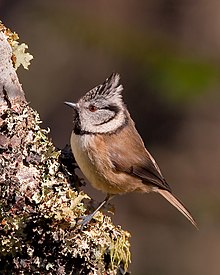| Tit | |
|---|---|

| |
| Crested tit in Scotland | |
| Scientific classification | |
| Domain: | Eukaryota |
| Kingdom: | Animalia |
| Phylum: | Chordata |
| Class: | Aves |
| Order: | Passeriformes |
| Infraorder: | Passerida |
| Family: | Paridae Vigors, 1825 |
| Genera | |
|
5–10, see text. | |

| |
| Global range (In green) | |
| Synonyms | |
|
See text | |
The tits, chickadees, and titmice constitute the Paridae, a large family of small passerine birds which occur mainly in the Northern Hemisphere and Africa. Most were formerly classified in the genus Parus.
Eurasian and African members of this family are referred to as "tits", while North American species are called either "chickadees" (onomatopoeic, derived from their distinctive "chick-a dee dee dee" alarm call)[1] or "titmice". The name titmouse is recorded from the 14th century, composed of the Old English name for the bird, mase (Proto-Germanic *maison, Dutch mees, German Meise), and tit, denoting something small. The former spelling, "titmose", was influenced by mouse in the 16th century.[2] Emigrants to New Zealand presumably identified some of the superficially similar birds of the genus Petroica of the family Petroicidae, the Australian robins, as members of the tit family, giving them the title tomtit, although, in fact, they are not related.
These birds are mainly small, stocky, woodland species with short, stout bills. Some have crests. They range in length from 10 to 22 cm (3.9 to 8.7 in). They are adaptable birds, with a mixed diet including seeds and insects.[3] Many species live around human habitation and come readily to bird feeders for nuts or seed, and learn to take other foods.
- ^ Cite error: The named reference
Merriamwas invoked but never defined (see the help page). - ^ Douglas Harper. "titmouse (n.)". Online Etymology Dictionary. Retrieved 2015-04-28.
- ^ Perrins, C. (1991). Forshaw, Joseph (ed.). Encyclopaedia of Animals: Birds. London: Merehurst Press. pp. 202–203. ISBN 1-85391-186-0.